20 years of stagnation interrupted by the collapse during the Financial Crisis and subsequent recovery.
By Wolf Richter for WOLF STREET.
Ford finally reported its new-vehicle deliveries this morning, after every other major automaker had reported their deliveries on Friday. So now we have the full picture of what happened with auto sales in 2019. These are deliveries by dealers to their customers, by automakers directly to large fleet customers such as rental fleets, and by automakers directly to their employees. The total was not pretty, but not every automaker was hit by declining sales.
Total new car and truck sales, retail and fleet, fell 1.2% in 2019, from a year ago and 2.5% from the peak in 2016, to 17.11 million vehicles. This makes it the third year in a row below the 2016 peak. And it was 1.4% below the prior peak set in the year 2000:
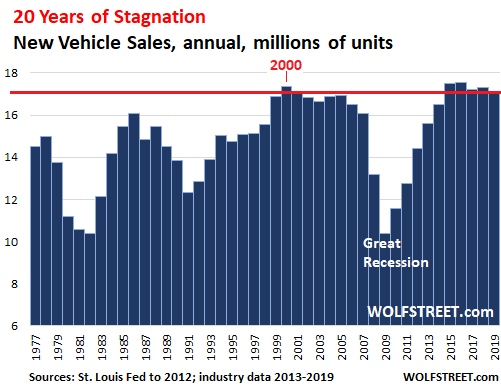
That total deliveries in 2019 of 17.1 million vehicles were below the 17.35 million deliveries in 2000 shows how horribly mature the market is despite a rising population. The market is impacted by a complex set of changes, including the continually rising average age of vehicles on the road and some structural trends, such as more people moving into high-rises at city centers – focus of much of the housing construction boom over the past decade – where cars are expensive to park and often less necessary.
The long-term trends of decline and stagnation were interrupted by the collapse of the auto industry during the Financial Crisis – with GM, Chrysler, and a substantial part of the component makers going bankrupt – and the subsequent recovery.
But for US automakers, the German automakers combined, and for Toyota, among the big ones, their peak was in 2015, as we’ll see in a moment. But now the trends are back on track.
General Motors: New-vehicle retail and fleet deliveries in 2019 fell 2.3% to 2.89 million units. This was down 5.1% from the recent peak in 2015 (3.08 million units) and took sales back below 2014 levels. Its market share ticked down to 16.9%:
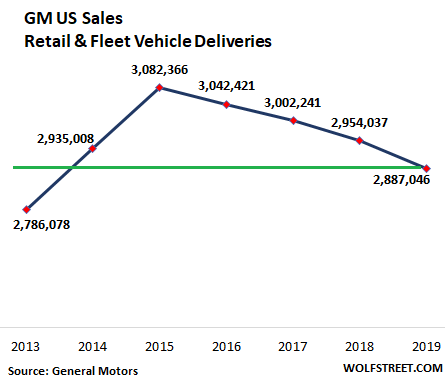
Some GM standouts:
- Fleet sales, such as deliveries to rental car companies, amounted to 21.8% of total sales, within the historic range.
- Sales of crossovers (compact SUVs) jumped 12.7% to 1.166 million units, now accounting for 40% of GM’s total sales.
- Crossovers have taken the place of sedans. Most of GM’s sedans are being phased out as sales have withered.
- Combined sales of the Chevrolet Silverado and the GMC Sierra pickups ticked down 1% to 802,962 units, accounting for 28% of GM’s total sales.
- But within the pickup group, crew cabs, which are four-door pickups, are hot, with sales of GM’s light-duty crew cabs soaring 15% in 2019. In its press release, GM said that “three out of every four full-size pickups GM sold were crew cabs,” at the expense of regular pickups.
Ford: New car and truck sales, which it finally reported this morning, fell 3% in 2019, to 2.42 million units, down 6.9% from the peak in 2015, and below its 2013 level. Its market share edged down to 14.2%:
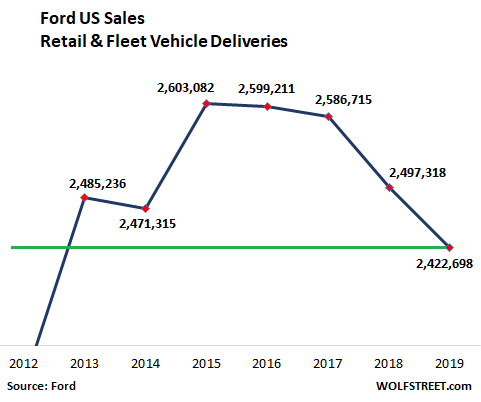
Same Ford standouts:
- F-Series sales ticked down 1.4% to 896,526 vehicles in 2019, accounting for 37% of Ford’s total sales.
- SUV sales, which includes crossovers, fell 4.8% in 2019 to 830,471.
- Car sales plunged 28% as Ford is phasing out most of its car lines.
- Transit and Transit Connect van sales soared 15% to 195,466 units, to 8% of Ford’s total sales, on the booming last-mile-delivery market that has become key to ecommerce, under relentless pressure from Amazon which in the span of a couple of years has created a network of 800 delivery companies with 75,000 drivers that all need vans.
Toyota: Sales at the third largest automaker in the US, fell 1.8% in 2019 to 2.38 million units, were down 4.7% from the peak in 2015, and were up just a hair from their 2014 level. Its market share edged down to 13.9%:
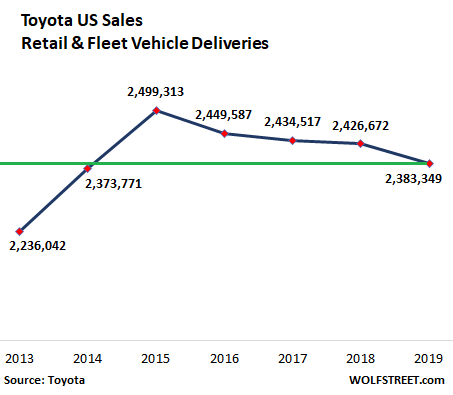
Despite Carmageddon, Toyota’s top two cars, the Camry and the Corolla, hung on, with Corolla sales ticking up 0.4% to 304,850 units in 2019 and Camry sales ticking down 1.9% to 336,978 units. Sales of all other Toyota-brand sedans plunged by the double digits, including the Prius (-20%). Total Toyota-branded sedan sales fell 4.0%. Sales of Lexus-branded sedans fell 12.6%. All sedan sales combined fell to 850,000, but still account for 36% of Toyota’s total sales, which is impressive compared to where sedan sales are at GM, Ford, and FCA.
Some other Toyota standouts:
- Toyota SUV sales ticked up 0.8% to 882,162 units. Within the group, the RAV4 sales rose 4.9% to 448,071 units
- Lexus SUV sales rose 5.6% to 217,139 units.
- Pickup truck sales fell 0.8% to 360,474 units.
FCA: Sales at the fourth-largest automaker in the US fell 1.4% to 2.204 million units in 2019 and were 2.7% below the peak in 2015.
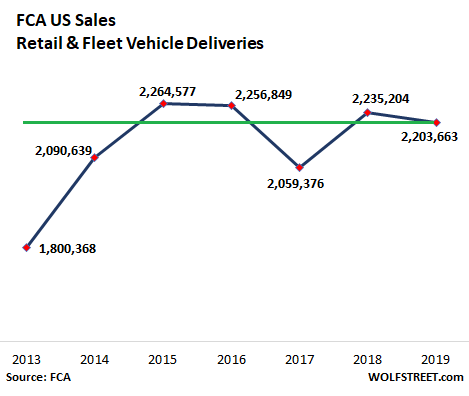
Of the top four automakers, FCA was the only one to book an increase in its pickup truck sales, following the redesign of its Ram trucks, whose sales jumped 18% in 2019 to a record 703,023 trucks, accounting for 32% of FCA’s total sales. The success of the redesigned RAM clearly ate into the sales of pickups at Ford, GM, and Toyota.
Also on the positive side at FCA:
- Grand Cherokee sales rose to a record 242,969 vehicles.
- FCA’s muscle car, the Dodge Charger, booked 96,935 sales in 2019, “the best since 2013.”
Honda: Sales at the fifth-largest automaker in US ticked down 0.2% in 2019 to 1.60 million vehicles, and were down 2.5% from the peak in 2017:
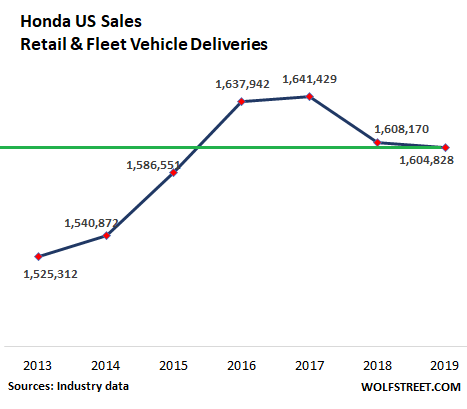
Nissan: Sales at the now deeply troubled automaker dropped 9.9% in 2019 to 1.35 million units and were down 15.5% from the peak in 2017, and were below 2014 levels.
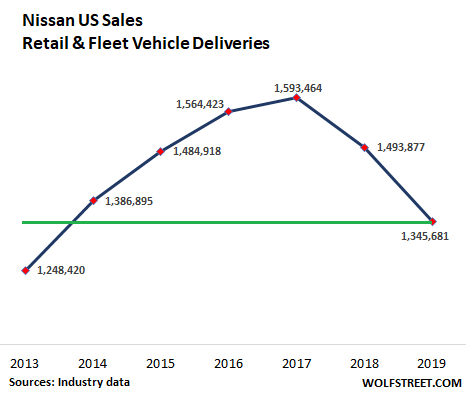
The other Japanese brands:
- Subaru’s sales rose 2.9% to a record 700,117 units in 2019, one of the few automakers to book a sales gain in the US ever year over the past five years.
- Mazda sales fell 7.2% to 278,552 vehicles in 2019, and were down 13% from 2015.
- Mitsubishi sales rose 2.5% to a record 121,046 units, having nearly doubled since 2013. The company was acquired by Nissan in 2016.
For all six Japanese automakers combined, total sales fell 2.9% in 2019 and were down 4.1% from the peak in 2017, and below their 2015 level. With 6.43 million cars and trucks sold in 2019, the Japanese automakers had a market share of 38%. Many of these vehicles are assembled in the US or Mexico.
The German automakers.
BMW, Mercedes-Benz, and Volkswagen Group all booked sales gains in 2019 in the US, with their combined sales rising 1.9% to 1.37 million units, but remain down 1.3% from their peak in 2015. They’re small: Their combined market share in the US is just 8%:
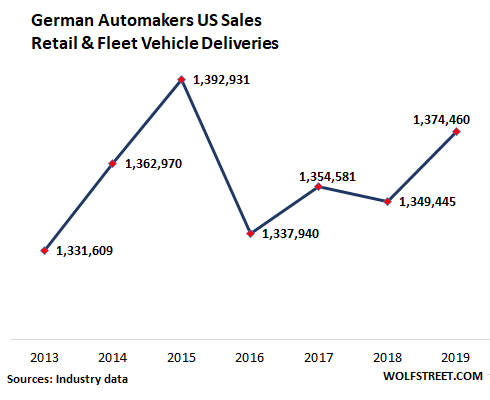
By automaker in 2019:
- Volkswagen Group sales – Volkswagen, Audi, Bentley, Lamborghini, and Porsche – rose 2.4% to 653,813. Within the group, Porsche sales fell 7.1% to 57,202.
- BMW sales increased 1.8% to 362,238 units but were down 10.6% from their peak in 2015.
- Mercedes-Benz sales ticked up 0.8% to 358,409 units, but were down 5.9% from their peak in 2016.
- In the eternal battle over being the number-one luxury brand, BMW was ahead by a tad of Mercedes-Benz once again.
The Korean automakers:
Hyundai and Kia, which are affiliated, went upscale and ran into a buzz saw of problems in 2017 and 2018 from which they’re now trying to recover.
- Hyundai sales rose 4.7% to 710,004 in 2019 but remain down 8.4% from the peak in 2016.
- Kia sales rose 4.4% to 615,338, but remain down 5.0% from their peak in 2016.
- Their combined sales rose 4.6% to 1.33 million units, but remain down 6.8% from their peak in 2016:
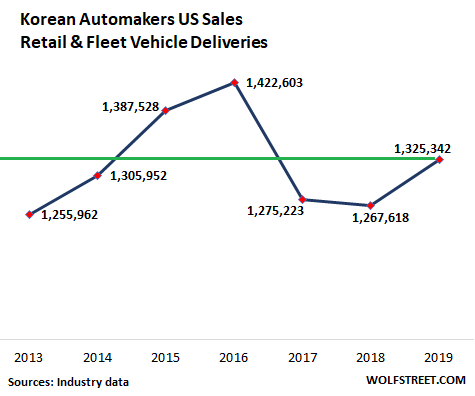
The Niche automakers:
Tesla does not disclose US deliveries. It only discloses global deliveries. So the industry guesses as to how many Teslas were sold in the US. Automotive News estimates that Tesla deliveries in the US surged 34% to 223,000 units in 2019. This gives Tesla a market share of 1.3% in the US.
Tesla is also the only automaker that went downscale. Its Model S and X could easily run over $100,000 each. But the Model 3 generally runs less than half that amount. Model X and S sales have plunged and Model 3 sales have surged. This has shown up in Tesla’s revenues, which declined over the 12-month period through Q3, even as total deliveries grew.
Sales of Tata-owned Jaguar Land Rover rose 2.6% to 125,787 units. Sales of Geely-owned Volvo rose 10.1% to 108,234 units. It was a record year for both of them.
Enjoy reading WOLF STREET and want to support it? You can donate. I appreciate it immensely. Click on the mug to find out how:
![]()


Everyone’s holding out, waiting in line for a Tesla. TSLA BTW, is the market leader.
“Tesla is also the only automaker that went downscale. Its Model S and X could easily run over $100,000 each. But the Model 3 generally runs less than half that amount. Model X and S sales have plunged and Model 3 sales have surged. This has shown up in Tesla’s revenues, which declined over the 12-month period through Q3, even as total deliveries grew.”
MUSK: You lose money on every model but we make it up on volume!
I don’t think Tesla is keen to keep Model S and Model X alive. It’d be phased out in due time to be replaced by Model Y and SUV.
Seems you forgot to add the sarc tag ;-]
Everyone wants a cybertruck!
Origami anyone ?? Lol.
That’s it! Now I know where I’ve seen that ‘pattern’ before!
I have read Ben Graham’s ‘The Intelligent Investor’ a couple of times. Tesla is the opposite of everything in that book. No earnings power, barely any interest coverage, its just a wild speculation.
Tesla only has 1.3% market share in this country, and yet its market cap is now approaching those Ford and GM combined. That’s crazy.
Ford is a death company and GM is not exactly going well so not that surprising. Tesla is a gamble. With a small bit of luck they have a decade of 30% profit and then a normal car company. If that is enough to make an investment in Tesla wih is something i don’t know.
GM made $7.7 billion in profits in 2018 (most recent full year data), on $147 billion in revenues. Tesla lost money on $24 billion in revenues. Yet Tesla has a bigger market cap (by almost double).
Listen, I’m impressed by what Tesla has done in the EV business; I just think the stock’s totally overvalued.
7.7billion on 147 billion is around 5%. That is not a good profit margin, especially if you believe that most of your business is in a market that will be death in a generation. And if you look at the way GM invests its money than you can conclude that it thinks that non-plugin hybrids and pure ICE are death in the near future.
Is Tesla overvalued? Yes, but GM and Ford are also overvalued
My van is over 25 years old and I see no reason to replace it in my lifetime. I drive less than 1000 miles/year – it is primarily my shelter, I travel mostly by bike.
At the rate the Fed devalues the dollar I need to use most of my income to buy assets. The Fed has given me no option if I want to survive after I can no longer work. If every penny goes into investments that, though they will protect me from losing all of my wealth to currency will inevitably not fully preserve my wealth, I have nothing left over to waste on frivolous, vanity purchases.
Buy a new vehicle? I can’t afford anything close to that kind of financial recklessness.
Every car article on Wolfstreet is like an invitation for people to post their personal car stories. The plural of anecdote is not data.
Yes, but it’s like coyote postings on Ring. Everyone complains but they watch the video anyway.
BTW, the comments on Jalopnik are frequently great. A fun blog. (Not as good as this one though!)
If I am not mistaken Lee Iococa started the 3 year car loan in the early sixties to move the iron.
1) Sold to dealer, not to the public, to exceed > 17M level.
2) A mix of 2019 dump to liquidate inventory & 2020’s.
3) A lot of 2019 promotions all over the place.
4) “I love it, I love it, I love, it’s mine” ==> is killing trucks.
5) Contractors buy vans, mostly Ford vans.
6) More space, cost less and ladies hate them.
“Sold to dealer, not to the public, to exceed > 17M level.”
Just to clarify: these numbers are “deliveries” to the end user, so from the dealer to the customer, or from the automaker directly to a large fleet such as Hertz, or from the automaker directly to its employees under its employee purchase program (big discount).
On the other hand, “revenues” — measured in dollars — are triggered when automakers invoice their dealers for vehicles that are being built. The dealer gets the invoice weeks before the vehicle arrives on the lot. This is where channel-stuffing can occur, not with deliveries. Revenues are reported quarterly, as part of the earnings report.
A couple of comments regarding Ford
Ford truck sales rose by 9.1%. F-Series sales declined by 1.4% but this must be viewed in light of this was the first full year for the Ranger. 90 thousand Rangers were sold. Given truck brand loyalty some part of Ranger sales came out of F-Series sales. Overall, Ford sold 1 million combined F-Series and Ranger pickups out of the 2.3 million vehicles they sold.
The big gainers for Ford trucks were the Transit, Transit Connect and Heavy Trucks. These added an additional 170,000 trucks making trucks one half of Ford sales.
My last new vehicle was bought in 2008. I have bought 8 total new. Being retired now the $58,000. it would take to buy one I would want (truck) would take two years of my annual income. I think I will pass. My first new one was a 65 SS impala, all the bells and whistles for $3600.00. Most of us older folks are just priced out. I sold all three major brands and spent a lot of years in the used car business. When I change, I will pay cash and buy used.
When there is a adequate selection of all electric vehicles in the near future, auto sales will rise again. The government will force adoption by banning ICE cars in the future. Shouldn’t be a surprise, look at Europe. Per capita auto ownership, however will drop like a stone. It seems to be the ‘plan’.
I am looking at two year old cars with low miles that are under a certified used warranty. For the brands we are looking, a typical new car warranty is 4 years, 40,000 miles. If there are 2 years left on the 2018’s warranty, the certified warranty extends it to 3 years. Then we sell it or keep it. Still have to look at expected resale value after three years.
I’m going to go out and buy a couple dozen 1995 pontiacs and front-run cash-for-clunkers Version 2.0 !!!
quite a 5 year run…..the number is a lot higher than I would have thought this late into the game….bodes well for service business over next decade
Again I am impressed with how high the sales are!
If you look at the last 30 years, it is still the 5th highest year of unit sales by the graph.
It certainly wouldn’t give me the impression that we are in recession. Cars are kept longer as they actually last longer; well probably cars manufactured between 1997 to 2007 as then started getting complicated with so many cheap quality elecronics in them.
I have no idea how much the population has gone up in the USA in that time and if so, I gather mainly due to immigration of the poorer economic migrant type that would more than likely be buying an old clunker as opposed to a new vehicle.
What would be interesting statistics would be the number of cars registered on the road by year.
Not so great when you consider:
The United States has added about 17 million people since the last major census in 2010, a 5.3 percent population growth. The increase has been steady over that time, at 0.7-0.8 percent a year. Jul 17, 2018
The Census keeps revising the numbers lower https://www.census.gov/newsroom/press-releases/2019/popest-nation.html
The nation’s population was 328,239,523 in 2019, growing by 0.5% between 2018 and 2019, or 1,552,022 people. Annual growth peaked at 0.73% this decade in the period between 2014 and 2015. The growth between 2018 and 2019 is a continuation of a multiyear slowdown since that period.
Willy,
But the increase in population is probably the economic migrants that will be taking the minimum wage and certainly cannot buy a new vehicle, so would buy second hand if at all.
Motor vehicles are lasting longer.
Just reading the comments on here, one can see that people are keeping their vehicles longer including myself.
One needs to do a graph by year of registered vehicles on the road.
The car/truck numbers in the 17 millions has been considered good. Some factors affecting this number: potential young drivers who do not want a license–they used to get parent’s used car and parent’s bought a new one. Individuals, businesses, and rental companies keeping vehicles longer. Below 17 million every year between 2001 to 2014 I have no great explanations. People bought too much house 2001 to 2006, then the recession, and during much of the recovery age of vehicles increased.
If one listens to YouTuber Scotty Kilmer:
You would expect a huge drop in new car sales as he says let someone else pay the initial depreciation.
Toyota Pickups, Toyota Corollas and Camrys and Ford F150s and Hondas should be holding up on new sales.
Nissan sales should have and have indeed crashed.
All the German car sales should have fallen, especially BMW that stands for “Big Money Waster”.
“Nobody with a brain would buy a Jaguar or Landrover” unless they had money to burn.
Chrysler and Fiat shouldn’t be able to sell one unit.
Scotty Kilmer is just the kind of person who should stick to a hammer and nail instead of giving advices on such complicated matters. You can like him – he’s funny – but he still remains the Jim Cramer of the automotive world. Basically a clown.
Here I always thought that BMW stood for break my window.
When my son was used car shopping with about $7000 a Mercedes S class was about the best used car value out there. People are scared to death of Mercedes repair costs but if you find a good mechanic a budget of $1000 per year ought to take care of all repairs.
That mechanic had better be (or employ) a good auto electronic tech and have the required expensive (and pay for software updates) diagnostic tools.
From where I come from, the traffic suggests we have too many vehicles. I’m praying for a solution.
Move.
You can’t force everyone else to leave an overpopulated area, but you sure can help lower the clutter and move somewhere less crowded.
It works as long as people from populated areas discover how calm and wild your new surrounding is and start using it as their favorite tourist location. My hometown has about just no cars on the streets on weekdays, but in the summer it’s like hell on wheels.
Early 2000 was the height of a long bull run. Soon after the economist Robert Shiller published “Irrational Exuberance,” there was the dot com NASDAQ crash. There was a global recession in 2001. It took years for the stock market to recover. On September 11, 2001 some Muslim hijackers crashed planes into two World Trade Center towers. They crashed a plane into the Pentagon. I had a coop apt in DC at the time. Smoke went up from the Pentagon burned for days.
One should not trade in cars too much. Warren Buffett kept a car for ten years. Keeping a car longer avoids depreciation, dealer fees, sales taxes etc. On the other hand keeping a car too long is nothing but service and parts expense.
A big part of this is the much better quality of the basic parts of the modern vehicles: structure, engine, trans, drive train.
People (like the 2nd and 3rd owners) can keep all the hang-ons going- starter, alternator, pumps, brakes, etc. If you do it yourself, the good engine and trans combinations (especially US small block v8 trucks, 4cyl imports, some 6 cyl US sedans) will run for a LONG time- as clunkers.
A lot of it is about squeezing an extra 5 years out of a vehicle that most people who frequent this blog wouldn’t think of owning.
Full disclosure- I probably own a few. My oldest car is a 1986. My newest is a 2005. I own ~ 6. I also roll around in ATF and brake fluid sometimes, but have plenty $ to buy a new car.
;)
Interesting article. However, cars do last longer these days. My neighbour has an F 150 with 450K on it and it’s still going strong. It has absolutely no value, but it works. Having said this, if you have transit options for work commutes, it doesn’t pay to own a vehicle. You would be far far ahead to rent a vehicle once in awhile than pony up the huge cash for a modern vehicle and watch it turn worthless in 10-15 years. Add in insurance, running costs, etc…. if I lived in a city the last thing I would buy is a car/truck. Cab the groceries home, or use a bike.
I do live in a city, although not in the city’s center. There’s two bus lines a block away, and the light-rail is a four minute walk from my front door. Very good public transportation is at the ready eighteen hours a day.
However, there’s no substitute for the being in control – complete control – of where and when you want to go somewhere. Yes, it costs money, and yes, it’s ingrained in the American psyche (at least my boomer generation), but it certainly adds to my quality of life. I feel very fortunate to have virtually every option for transit at my beck and call.
As Wolf so correctly points out though, younger and retirement aged people who live in large cities are losing the need to own motorized vehicles.
I had to calculate how old my vehicle is, 14 years—I just don’t care anymore. Every time I think I should replace it, I calculate the sales tax and registration fees on a new/er vehicle—it’s cheaper to spend $300 in repairs every year than paying increased registration fees each year. I hardly drive anywhere anymore (a plus). Oil change later this week—independent shop washes and dries it, treats me great :D Way better service than manufacturer’s dealership that charges 2x—won’t waste money on dealership repairs/service again (GM). Have to drive relatives’ brand-new 4-cyl vehicles occasionally; I have to LOL at the noise levels and ride quality on those! Oh yeah, most importantly, I just don’t want to deal with car salesmen anymore! Or the pricing schemes.
Edit to add: those junky 4-cyl vehicles are GM.
The schemes are the worst. I know a lot of people who have fallen for the trade in scams they run. Folding the outstanding balance of the older vehicle that isn’t paid off into the new loan so the new vehicle buries them deeper. Should be a crime, yet it happens every day.
They always find a way to keep the payments the same, but your vehicle is newer and shinier. You just owe for 5 yrs longer, everyone likes to brag the vehicles will last that long anyway. They just never keep em long enough to find out.
Considering that the US was capable of buying 15 million new cars in 1978 and has rarely exceeded 17 million in sales since then (over 40 yrs ago) suggests a lot about the declining economic well being of the US – and maybe the price/product mix decisions of the automakers (who have intentionally crippled low end design and engaged in endless financing f*ckery pokery, screwing both buyers of cars and investors in securitized auto loans).
…and the population has increased 100,000,000 since then
Own a 17year old Honda… 200k Adhered to maintenance and body work over the years so the paint is still looking fresh, also white paint doesn’t show scratches, FYI!
And It’s still driving great. Small maintenance bill and reliable transportation makes it hard to give up. I can’t believe cars can last this long. It doesn’t even look like it’s a relic, since cars have barely changed styling in 20years.
I will run it into the ground and when she dies I will reduce down to 1car in my driveway since we live in an urban neighborhood with trains, ride share, cArshare , bike share, scooter share galore.
Ownership is no longer mandatory or financially sensible.
I might also add that it used to be a miracle to get 75k on a car from the 70s, then it was 100k in the 80s and 150k in the 90s. TodAy the benchmark is pushing 250k or higher. Modern electrics should be capable of 400k and possibly 1million.
The economics have changed dramatically. If you’re ok with owning a car for 20-30years you can do that now especially with electrics. This is why Tesla is winning. The Cybertruck will first be laughed at by MAGA country, but when they discover its half the lifetime cost of a F150 they will buy them in droves.
I have electric car and biggest problem with electric vehicle apart from compliance system is battery capacity degradation which is super super expensive if it has come down to replacing when out of warranty
Not compliance but complicated
I rented the Rav4 Hybrid for 2 weeks. I really enjoyed the simpleness of the design. Hybrid designs would seem to be the ticket, in being used in a much more variety of occasions, with great mileage.
Hi Wolf.
Interesting figures. Looking at that graph it appears that the media annual sales figure of around 15 million vehicles over the last 43 years.
So anything above 15 million isn’t too bad. Although given the larger population – certainly not great.
Also, it looks like these years are wrong.
BMW sales increased 1.8% to 362,238 units but were down 10.6% from their peak in 2016.
Mercedes-Benz sales ticked up 0.8% to 358,409 units, but were down 5.9% from their peak in 2016.
Surely they should be referencing 2015.
Julian,
In terms of 15 million units: that would be a severe recession in the US auto sector with lots of layoffs and plant closings. The whole industry is set up to grow, not to decline.
There are now many more automakers carving up the pie than 43 years ago. This includes the Koreans. 43 years ago, the Japanese cars were still called “rust buckets,” though they were starting to build good cars at the time that were winning the hearts and minds of Americans (including the Z, of which I bought one in 78). But they were still bit players. Now they dominate. AMC (not the movie theater chain) still existed back then. And in 1977, the US population was 220 million. In 2019, it was 328 million. That’s a 50% increase.
In terms of the dates: The German automakers didn’t move in lockstep. The chart shows the three brands combined.
Volkswagen Group sales peaked in 2013 then got close to that level in 2015 and then dropped sharply in 2016 (dieselgate) and then rose past those levels.
BMW peaked in 2015 then dropped. This is the one where I had the wrong year in the text, and I fixed that. Thanks.
MB peaked in 2016, then dropped.
Wolf,
I wonder what the anemic, volatile growth in US sales over 40 yrs says about,
1) US makers pathetic ability to create cost saving innovations (compàre computer price and sales volume trends)
2) The neutralization of foreign maker cost savings due to US interest rate policy (and related dollar depreciation)
I think the two big factors for why the market is so mature despite population growth are: 1. the rising average age of vehicles on the road (they last much longer); and 2. the re-concentration of construction in city centers. High-rises near work or transportation hubs make it more expensive and less necessary to own a car (and two-adult households might just have one car).
driving around my area of South Carolina shows the volumes of used and new car lots are all full of cars. I watch the front lines of the lots and most change little each week on the used car side. The trucks seem to move off the lot. The new cars change a good bit and locally people don’t drive old cars like my wife and I. The restaurants are all full lots too every night it seems. There are people spending money, whether borrowed or enjoying retirement or those hard earned dollars actually working. Housing here is selling HOT. Assume transplants from everywhere because it is filling up the roads and land lots full of people.
Good information Wolf. Manufacturers continue to improve production and process efficiency driving down their cost structure (sans electric vehicle development costs) so even with lower volumes, most can make a go of it. Is FCA taking pickup share with price concessions? Any thoughts on how fed rate costs impacted unit volume in ‘19 vs ‘18?
They have stopped long-term investing in ICE cars. Your cost structure goes down if you don’t develop the engine that will replace your current engine in 10 years
A relative works in the home mortgage section of a bank. The comments from her are interesting. She says that most people buy a car using a loan or lease a car. Thereby having a payment due each month and then when the lease term is up or the loan is payed off they just go and do it all over again. So they have a forever payment.
I look back over the years at my neighbors and sure enough they seem to change cars every 3-4-5 years.
It would seem this is exactly what the dealers and car companies want. You just pay forever.
I often wonder if they even think about why I never change cars. Like many posters here I drive cars until that have >300k miles on them and I’ve gotten every penny of value from the vehicle. This includes cars I’ve owned back in the 70’s and 80’s. Japanese cars and some Euro cars had great reliability.
I am 53 and was mad keen to get a car at 17 in UK. Lived on a farm and wanted to get about. Then lived in a city and gave up the car until I got married and had children.
My young relatives. Many dont have driving licences Uber etc, aren’t getting married until much later and having fewer if any children.
But they eat out, go on holiday 2-3 times a year etc.
Times are changing I guess.